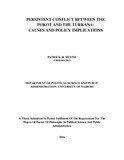Persistent Conflict Between the Pokot and the Turkana: Causes and Policy Implications

View/
Date
2016Author
Devine, Patrick R
Type
ThesisLanguage
en_USMetadata
Show full item recordAbstract
The study is about the conflict between the Pokot and the Turkana communities in the North Rift of Kenya. This conflict has persisted since precolonial times. Apart from the conflict management interventions of the State, the other main actor trying to manage the conflict is the Catholic Church. The Catholic Church‟s activities of conflict management complement those of the State. Thus, the problem that this study sought to address is why the Pokot-Turkana conflict persists despite the interventions by the State and the Catholic Church. This study is guided by three hypotheses which were derived from the study‟s objectives. The first hypothesis is about underlying causes of the conflict, the second is about State approaches to managing the conflict and the third is about the Catholic Church‟s activities of managing the conflict. The hypotheses as well as the objectives with which they resonate were informed by wide ranging pertinent social sciences and humanities literature within the purview of conflict and peace. The study was guided by structural violence theory. The research design employed was cross-sectional sample survey wherein 381 cases comprising Pokots and Turkanas were selected through cluster sampling. Quantitative data was collected from these cases through structured questionnaire, supplemented by focus group discussions and interview data. The hypotheses were tested using factor analysis, Pearson correlation, analysis of covariance and multiple regression/correlation. Factor analysis was applied to the first hypothesis. Pearson correlation and analysis of covariance were applied to the second hypothesis and multiple regression/correlation and skewness were applied to the third hypothesis. Statistical test results were as specified below. Three underlying causes of the conflict, namely, core resources, political economy and infrastructure insecurity were identified and explained. In the second hypothesis it was found that State approaches to managing the conflict are not effective. With regard to the third hypothesis it was demonstrated that some activities of the Catholic Church significantly contribute to management of the conflict while other activities do not make a significant contribution. Thus the results are inconclusive. This suggests that further research needs to be done in order to clarify the nature and dynamics of the Catholic Church‟s activities of contributing to management of the conflict. This research is significant because it points to a need to carry out comprehensive quantitative research into why the conflict continues to persist in post-colonial Kenya. For both the State and Church the crucial objects of management approaches/activities, with achieving long lasting Pokot-Turkana peaceful coexistence as the end in view, is human security; economic political, environmental and cultural. In terms of statistical inference, the results of hypotheses testing warrant stating that the peaceful coexistence is far from being in sight.
Publisher
University of Nairobi
Rights
Attribution-NonCommercial-NoDerivs 3.0 United StatesUsage Rights
http://creativecommons.org/licenses/by-nc-nd/3.0/us/Collections
The following license files are associated with this item:

